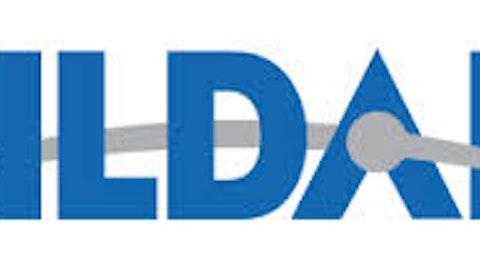Abercrombie & Fitch Co. (NYSE:ANF) shareholders have had a bit of a roller-coaster ride over the past several years. This company has several brands that are and have been popular among the “cool kids” even since I was in high school. However, as their products are relatively expensive, the recession of a few years ago hit Abercrombie particularly hard, as it did most retailers of “luxury” items.
With the massively declining sales during the recession, the stock hit a low of $13.66 in 2009, down from the peak of $85.77 just the year before. Since then, the company’s cost-cutting and growth efforts have paid off; sales are up, and the shares have rebounded nicely. With the company set to report earnings on February 13, shareholders will be looking for signs that in 2012 the company continued on the right path for growth.
Abercrombie has been around since 1892; however, it gained its widespread popularity much more recently, with most of its rapid growth occurring in the 1990’s. Sales rose from $85 million in 1992 to $1 billion by 1999, and have continued to climb steadily to over $4 billion today.
The company operates four retail brands; Abercrombie and Fitch, Abercrombie Kids, Gilly Hicks, and Hollister Co., with a total of over 1,000 stores. Most of the company’s stores are in the U.S., with 131 of the stores being international.
Abercrombie’s target demographic is the 7-24 age group, with a special emphasis on teenagers (and those who wish they were still teenagers). According to consumer data reports, this age group accounts for 31% of apparel spending, with teenagers accounting for 18%. Teens tend to have the most apparel spending influence of all age groups, which is the main reason that Abercrombie (and others) tailor their clothing lines to teens’ preference.
Growth Prospects
Abercrombie’s plans to increase shareholder value are more focused on getting rid of underperforming stores than they are on growth and expansion. Since 2010 the company has closed 135 stores, with another 180 underperforming stores identified as possible closures by 2016. The company wants the primary driver of growth to be increasing same-store sales, as well as increasing their online business, where overhead is much less.
That said, there are some international markets that Abercrombie has active plans to expand into, particularly the U.K, Canada, and Asia. During 2013, the company plans to open a total of 40 stores (mostly Hollister) in those countries.
Finally, one of the best ways the company plans to return value to its shareholders is through its aggressive buyback program, which was increased this past year to authorized buybacks of 22.9 million shares. Bear in mind, there are only 79.6 million outstanding shares currently.
Valuation
Speaking of creating shareholder value, those who invest now may be handsomely rewarded if the company’s plans pan out over the next few years. When the company reports its earnings, the consensus calls for $2.98 per share for the fiscal year, meaning Abercrombie trades at 17.1 times earnings.
Earnings are projected to grow to $3.57 and $4.19 over the next two years, or earnings growth of 19.8% and 17.4%, which is outstanding for a 17.1 P/E ratio. The main reason the shares are not valued higher are the high level of risk perceived in regards to the economy and whether or not the company will be able to deliver increased earnings while closing stores.
Competition
There are a great deal of clothing retailers, all of which cater to slightly different tastes and age groups. For comparison purposes, I would say the two most closely-related companies are American Eagle Outfitters (NYSE:AEO) and Aeropostale, Inc. (NYSE:ARO). These two cater to the same demographic as Abercrombie, with American Eagle the most similar. Aeropostale is more targeted toward value-oriented rather than trend-oriented consumers, however all three companies compete for the teenage dollar.
American Eagle actually trades at a slightly lower valuation of 14.5 times earnings; however, the growth potential of Abercrombie simply is not there. This year’s earnings of $1.40 are expected to rise to $1.56 and $1.76, for growth of 11.4% and 12.8%. While this is nothing to turn up your nose at, Abercrombie clearly has more potential, but more risk.
Aeropostale on the other hand, has very nice growth prospects, but is a bit more expensive at about 20 times earnings. I am hesitant to consider Aeropostale as an investment due to the fact that its revenues have actually declined over the past couple years (same store sales fell 9% for the holiday season this past year). There is a further 3% decline projected in 2013. Despite analysts’ projections of earnings growth, I am hesitant to invest in any company with declining sales, especially during an economic recovery.
Conclusion
Out of the three companies mentioned, Abercrombie simply makes the most sense as an investment. During the earnings call, I will be paying particular attention to the progress of closing (or revamping) the underperforming stores, as well as any planned openings of new stores in untapped international markets, as this will be a major indicator of future growth.
The article Great Brands And A Great Plan originally appeared on Fool.com and is written by Matthew Frankel.
Copyright © 1995 – 2013 The Motley Fool, LLC. All rights reserved. The Motley Fool has a disclosure policy.






